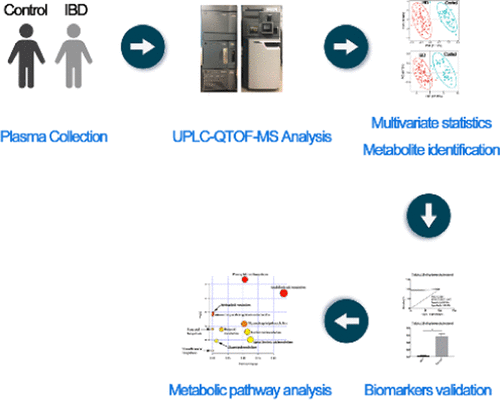当前位置:
X-MOL 学术
›
J. Proteome Res.
›
论文详情
Our official English website, www.x-mol.net, welcomes your
feedback! (Note: you will need to create a separate account there.)
UPLC-QTOF-MS-Based Plasma Lipidomic Profiling Reveals Biomarkers for Inflammatory Bowel Disease Diagnosis.
Journal of Proteome Research ( IF 3.8 ) Pub Date : 2019-12-26 , DOI: 10.1021/acs.jproteome.9b00440 Su Guan 1 , Bingjie Jia 1 , Kang Chao 2 , Xia Zhu 3 , Jian Tang 2 , Miao Li 2 , Lvying Wu 1 , Lei Xing 1 , Kun Liu 1 , Lei Zhang 1 , Xueding Wang 3 , Xiang Gao 2 , Min Huang 3
Journal of Proteome Research ( IF 3.8 ) Pub Date : 2019-12-26 , DOI: 10.1021/acs.jproteome.9b00440 Su Guan 1 , Bingjie Jia 1 , Kang Chao 2 , Xia Zhu 3 , Jian Tang 2 , Miao Li 2 , Lvying Wu 1 , Lei Xing 1 , Kun Liu 1 , Lei Zhang 1 , Xueding Wang 3 , Xiang Gao 2 , Min Huang 3
Affiliation

|
Identification of new biomarkers may help in the early diagnosis of inflammatory bowel disease (IBD). In this study, ultrahigh-performance liquid chromatography equipped with quadrupole time-of-flight mass spectrometry (UPLC-QTOF-MS) was used to analyze the untargeted lipidomics and compare plasma lipid profiles between IBD patients and control subjects. The principal component analysis and partial least-squares-discriminant analysis were carried out to distinguish IBD patients from control subjects. Using univariate and multivariate analysis, 55 significantly different metabolites from five lipid classes, fatty acyls (n = 19), glycerophospholipids (n = 5), prenol lipids (n = 10), sphingolipids (n = 2), and sterol lipids (n = 19) were identified. Forty-four of the 55 metabolites were analyzed by receiver operating characteristic (ROC) curve and area under curve (AUC) of >0.80. After validation in an independent cohort, IBD patients were differentiated from the control subjects by significantly altered plasma level of palmitic acid, 7alpha, 25-dihydroxycholesterol, 20-hydroxyeicosatetraenoic (HETE)-d6, (+/-)5,6-epoxy-eicosatrienoic acid (EpETrE), docosahexaenoic acid (DHA), 9-heptadecylenic acid, lactucaxanthin, α-carotene, traumatic acid, and neoquassin with both sensitivity and specificity above 80%. Pathway analysis suggested that IBD dysregulation was related to the biosynthesis of primary bile acid, the metabolism of arachidonic acid, the metabolism of sphingolipid, fatty acid elongation, and glycerophospholipid metabolism. Our results suggest that the lipidomic profiling of patients plasma could be a potential method for IBD diagnosis.
中文翻译:

基于UPLC-QTOF-MS的血浆脂质组学分析揭示了用于炎症性肠病诊断的生物标志物。
新生物标志物的鉴定可能有助于炎症性肠病(IBD)的早期诊断。在这项研究中,配备了四极杆飞行时间质谱(UPLC-QTOF-MS)的超高效液相色谱仪被用于分析非靶向脂质组学,并比较了IBD患者和对照组之间的血浆脂质谱。进行主成分分析和偏最小二乘判别分析以区分IBD患者和对照组。使用单变量和多变量分析,从五种脂类,脂酰(n = 19),甘油磷脂(n = 5),早搏酚脂(n = 10),鞘脂(n = 2)和固醇脂(n = 19)。通过受试者工作特征(ROC)曲线和> 0.80的曲线下面积(AUC)分析了55种代谢产物中的44种。在独立队列中进行验证后,IBD患者通过显着改变的棕榈酸,7alpha,25-二羟基胆固醇,20-羟基二十碳四烯酸(HETE)-d6,(+/-)5,6-环氧-二十碳三烯酸(EpETrE),二十二碳六烯酸(DHA),9-庚二烯酸,乳糖黄嘌呤,α-胡萝卜素,创伤性酸和新花红素,其敏感性和特异性均在80%以上。通路分析表明,IBD失调与伯胆汁酸的生物合成,花生四烯酸的代谢,鞘脂的代谢,脂肪酸的延长和甘油磷脂的代谢有关。
更新日期:2019-12-27
中文翻译:

基于UPLC-QTOF-MS的血浆脂质组学分析揭示了用于炎症性肠病诊断的生物标志物。
新生物标志物的鉴定可能有助于炎症性肠病(IBD)的早期诊断。在这项研究中,配备了四极杆飞行时间质谱(UPLC-QTOF-MS)的超高效液相色谱仪被用于分析非靶向脂质组学,并比较了IBD患者和对照组之间的血浆脂质谱。进行主成分分析和偏最小二乘判别分析以区分IBD患者和对照组。使用单变量和多变量分析,从五种脂类,脂酰(n = 19),甘油磷脂(n = 5),早搏酚脂(n = 10),鞘脂(n = 2)和固醇脂(n = 19)。通过受试者工作特征(ROC)曲线和> 0.80的曲线下面积(AUC)分析了55种代谢产物中的44种。在独立队列中进行验证后,IBD患者通过显着改变的棕榈酸,7alpha,25-二羟基胆固醇,20-羟基二十碳四烯酸(HETE)-d6,(+/-)5,6-环氧-二十碳三烯酸(EpETrE),二十二碳六烯酸(DHA),9-庚二烯酸,乳糖黄嘌呤,α-胡萝卜素,创伤性酸和新花红素,其敏感性和特异性均在80%以上。通路分析表明,IBD失调与伯胆汁酸的生物合成,花生四烯酸的代谢,鞘脂的代谢,脂肪酸的延长和甘油磷脂的代谢有关。











































 京公网安备 11010802027423号
京公网安备 11010802027423号